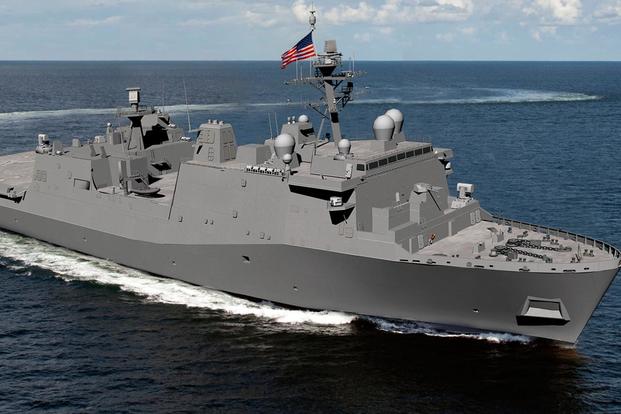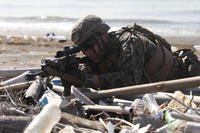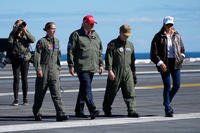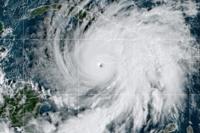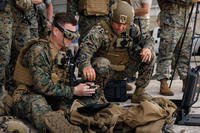The days of treating amphibious ships like shuttle buses that get Marines to the fight are over.
The commandant of the Marine Corps wants his troops to be able to "fight to get to the fight," and that may mean shaking up the loadout of the amphibious assault ship -- and possibly leaving some personnel and gear off in favor of equipment that boosts the ship's lethal power.
Speaking at the Surface Navy Association's annual symposium near Washington, D.C., Marine Maj. Gen. David Coffman, the Navy's director of expeditionary warfare, said he wants to get the service thinking differently about how to use its beloved amphibs.
Years ago, he said, the ships were viewed exclusively based on what they could carry.
"How many aircraft can you embark and operate, how many landing craft ... vehicles, rolling stock, square footage, how much cargo ... how many troops can you put in racks," he said. "That is important. But that's not an amphibious warship; that's a truck."
When troops are transiting through the Straits of Hormuz or the Bab Al Mandab on a ship, the reality of the potential threat they face comes home, Coffman said.
Related content:
- In a First, Marines Shoot HIMARS Rocket from Amphibious Ship
- Lockheed Martin Wants to Put Missile Launchers on Amphibious Ships
- Equipment Guide: Amphibious Ships
In fall 2016, the crew of the destroyer Mason had to employ defensive measures when it was fired on in the Bab Al Mandab by missiles shot by Houthi rebels from the coast of Yemen.
"I make the captain do the lifeboat drill. Then I walk [around] and ask the Marines, 'Why are we doing this drill?' " Coffman said. "Because you might get sunk. And how tragic if all this combat capability, not to say the lives, are at the bottom of the ocean because we could not figure out how to integrate, physically, technically and operationally, such that we can win both the sea control and the power projection fight."
It's about minor trade-offs, Coffman said.
"The 1,232nd lance corporal in [battalion landing team] 1/1 is not as important to me as what he's doing with C5I on that ship," he said, using the acronym for command, control, communications, computers, collaboration, and intelligence.
"The 1,230th to 1,252nd lance corporal on that ship and the last seven Humvees and other stuff, get rid of all of them. You mean I'm going to get some special ops, irregular warfare capability; you mean I'm going to get some enhanced [signals intelligence]; you mean I'm going to get some better radars; you mean I'm going to get fires to do some of my own killing?" Coffman said. "Thank you, Marines, for your interest in national service. We'll see you at the beach, or we'll get you there another way."
This shift is already taking place to some extent. The LX(R) future amphibious ship design includes 650 berthing spaces for Marines, compared with 700 in the San Antonio-class amphibious assault ship that LX(R) is planned to succeed, a design change spurred by cost concerns and capability needs.
The Corps has also begun actively exploring ways to add lethality to the amphibious ship.
In a proof-of-concept exercise in October, the service fired a HIMARS rocket from the amphibious transport dock Anchorage while it was off the West Coast, obliterating a land-based target 70 miles away.
Marine Corps Commandant Gen. Robert Neller has also publicly discussed his interest in using the available space for vertical launching system, or VLS, cells aboard the San Antonio-class amphibs to enable the ships to fire missiles.
Other technology or capability additions may be yet to be determined.
"Here's a deck on a future [amphibious] ship. What's going to go on there? I don't know yet," Coffman said. "Whatever the right person buys. Or ... what the commandant buys."
Coffman emphasized than any loadout trade-offs for amphibious ships will be on the margin, rather than wholesale swaps.
"The main battery of the L-Class amphibious assault warship is the embarked [Marine air-ground task force]," he said. "We wouldn't buy [amphibs] just to do sea control. We'd buy cruisers and destroyers or future combatants. Our proposition is, we probably need the diversity of all those things."
-- Hope Hodge Seck can be reached at hope.seck@military.com. Follow her on Twitter at @HopeSeck.
